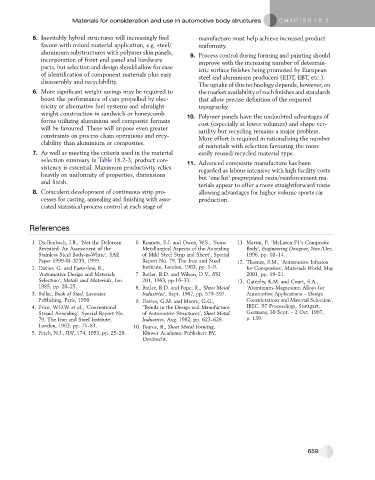Page 651 - Automotive Engineering Powertrain Chassis System and Vehicle Body
P. 651
Materials for consideration and use in automotive body structures C HAPTER 18.2
5. Inevitably hybrid structures will increasingly find manufacture must help achieve increased product
favour with mixed material application, e.g. steel/ uniformity.
aluminium substructures with polymer skin panels, 9. Process control during forming and painting should
incorporation of front end panel and hardware improve with the increasing number of determin-
parts, but selection and design should allow for ease istic surface finishes being promoted by European
of identification of component materials plus easy steel and aluminium producers (EDT, EBT, etc.).
disassembly and recyclability.
The uptake of this technology depends, however, on
6. More significant weight savings may be required to the market availability of such finishes and standards
boost the performance of cars propelled by elec- that allow precise definition of the required
tricity or alternative fuel systems and ultralight- topography.
weight construction in sandwich or honeycomb 10. Polymer panels have the undoubted advantages of
forms utilizing aluminium and composite formats cost (especially at lower volumes) and shape ver-
will be favoured. These will impose even greater satility but recycling remains a major problem.
constraints on process chain operations and recy- More effort is required in rationalizing the number
clability than aluminium or composites.
of materials with selection favouring the more
7. As well as meeting the criteria used in the material easily reused/recycled material type.
selection summary in Table 18.2-3, product con- 11. Advanced composite manufacture has been
sistency is essential. Maximum productivity relies regarded as labour intensive with high facility costs
heavily on uniformity of properties, dimensions but ‘one hit’ preprepared resin/reinforcement ma-
and finish.
terials appear to offer a more straightforward route
8. Coincident development of continuous strip pro- allowing advantages for higher volume sports car
cesses for casting, annealing and finishing with asso- production.
ciated statistical process control at each stage of
References
1. Dieffenbach, J.R., ‘Not the Delorean 6. Kennett, S.J. and Owen, W.S., ‘Some 11. Martin, P., ‘McLaren F1’s Composite
Revisited: An Assessment of the Metallurgical Aspects of the Annealing Body’, Engineering Designer, Nov./Dec.
Stainless Steel Body-in-White’, SAE of Mild Steel Strip and Sheet’, Special 1996, pp. 10–14.
Paper 1999-01-3239, 1999. Report No. 79, The Iron and Steel 12. Thomas, S.M., ‘Automotive Infusion
2. Davies, G. and Easterlow, R., Institute, London, 1963, pp. 1–9. for Composites’, Materials World, May
‘Automotive Design and Materials 7. Butler, R.D. and Wilson, D.V., JISI, 2001, pp. 19–21.
Selection’, Metals and Materials, Jan. 201, 1963, pp.16–33. 13. Gatenby, K.M. and Court, S.A.,
1985, pp. 20–25. 8. Butler, R.D. and Pope, R., ‘Sheet Metal ‘Aluminium–Magnesium Alloys for
3. Sollac, Book of Steel, Lavoisier Industries’, Sept. 1967, pp. 579–597. Automotive Applications – Design
Publishing, Paris, 1996. 9. Davies, G.M. and Moore, G.G., Considerations and Material Selection’,
4. Price, W.O.W. et al., ‘Conventional ‘Trends in the Design and Manufacture IBEC ’97 Proceedings, Stuttgart,
Strand Annealing’, Special Report No. of Automotive Structures’, Sheet Metal Germany, 30 Sept. – 2 Oct. 1997,
79, The Iron and Steel Institute, Industries, Aug. 1982, pp. 623–628. p. 139.
London, 1963, pp. 71–81. 10. Pearce, R., Sheet Metal Forming,
5. Petch, N.J., JISI, 174, 1953, pp. 25–28. Kluwer Academic Publishers BV,
Dordrecht.
659

